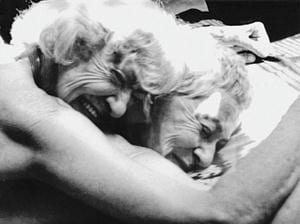
A scene from Nitrate Kisses, Hammer's 1992 experimental film about the marginalization of queer people.
Barbara Hammer’s multifaceted 45-year oeuvre spans continents, themes and styles, but it can be roughly divided into the early celebrations of lesbian identity of the 1970s; the more experimental, optical printing period of the 1980s; the return of identity politics in the 1990s with films that question the writing of history; and reaching to the present, the cultural biographies of lesbians.
“But then, there’s always been a political side of me that’s broader than queer identity,” the filmmaker explains, in a Skype interview ahead of her visit to Toronto for a TIFF Cinematheque retrospective of her work and an event at the Images Festival. “Peace and freedom, the very basic human rights… something I dealt with in Resisting Paradise and more recently in my work on Palestine.” Then there is her recurring interest in the issues surrounding mortality and fragility of the body that goes back years before she made the recent A Horse Is Not a Metaphor, about her own struggles with ovarian cancer. “My interests have been expanding, collapsing, going global, returning to myself.”
Apart from the April events, Torontonians can see a good number of Hammer’s films any time at the Canadian Filmmakers Distribution Centre, at 401 Richmond St. Her autobiography, Hammer! Making Movies out of Sex and Life (2010), is an invaluable companion to her films.
The Dyketactics series of short films that she made as a young, newly out dyke will read today as refreshingly focused on multiplicity — bodies and pleasures, joint forces and collective action — rather than the couple, which today seems to be the dominant concern. “Yes, there was more of a community focus then… The concerns of today probably boil down to the dyad because of the struggle for equal marriage and the civil liberties situation in the US. I’ve never been in favour of marriage myself, but I am in favour of all civil liberties that we don’t have.” One side of the community focus of the early lesbian activism saw a lot of sex happening. “There was a lot of non-monogamy and serial monogamy going on. We all came out together and discovered that we were attracted to one another and wanted to experiment. We were passing each other around — at least I was — very quickly.”
All this is documented in Hammer’s diaries, which remain unpublished, apart from the excerpt “My Life as Henry Miller” in Hammer! Here we follow her dealing with a very old question, one that, however, women had rarely had the freedom to be in a position to ask: can we be the ethical Don Giovannis — can we reeducate and free our desire from the marital to the multiple and still be good? “After many years of being the Donna Giovanna, I was in therapy, and my therapist posed it to me as a matter of choice: do you want to continue this behaviour of three-month relationships or do you want to try something different? And I decided to try the risk — and the risk-taking for me at that time was having a long relationship.”
Many of Hammer’s films and writings probe the habits of loving that women may fall into. “There is always in relationships between women a return to the mother-daughter relationship,” reads a voiceover in a sequence in Tender Fictions. Says Hammer, “I don’t think all lesbian and queer relationships are like that. But I think we have to look at that question. Even in heterosexual relationships it’s said that you choose your partner to work out your familial relations with… It’s important to be intelligent and curious about our relational behaviour.” Loving somebody as different than oneself does not come naturally for anybody. “It’s important to really embrace somebody as separate and to love that difference and allow it and celebrate it. Even to the point of letting go. Even if that person says, I’m going to move on.”
Yet another important aspect of Hammer’s oeuvre is that it is an eloquent articulation of the kiki position — those of us who do not feel particularly attached to either the femme or the butch role, who move between one and the other depending on context or are permanently somewhere else entirely. “I like role-playing… but we are the freest when we can adapt and adopt multiple personalities, costumes and positions of being in the world and within ourselves individually… I have both the butch and the femme within my performances, and I can’t deny that I personally can go either way, depending on the person I’m with.”
Regarding the relationship between desire and art, Hammer effectively reverses Freud. If for Freud, artistic creation is sublimation of desire, for Hammer it is an explosion of desire. “Following desire is what allows you to make art,” she says. It’s always the current project that fires her: it propels the research of her subject, and it’s both intellectual and desire for adventure and physical travel, “to capture what I don’t have and don’t know.” When she gets enough, she starts to edit. “Then the desire is to search for form.” There is frustration along the way. “You just have to persevere to get back to your pleasure of a desire satisfied.”
The new work that is fuelling Hammer right now is a documentary on the late, great poet Elizabeth Bishop. “It’s a little bit dangerous since I am working with a well-known person’s biography. I’ll be going to Nova Scotia in the summer to visit her childhood home. The work is exploring her lesbian life — in a provocative manner, I hope.” And if you knew Bishop, Hammer wants to hear from you. “Even if you know stories about her or know somebody who knew her, make sure to get in touch with me.”

 Why you can trust Xtra
Why you can trust Xtra


